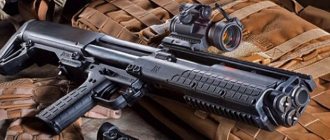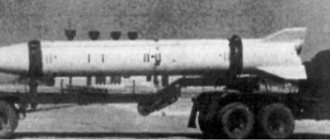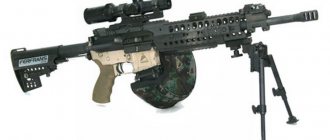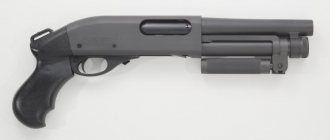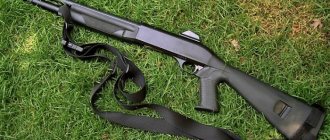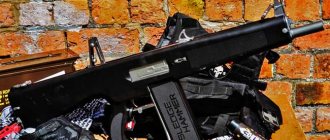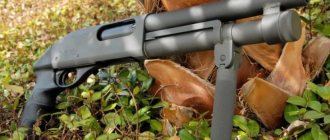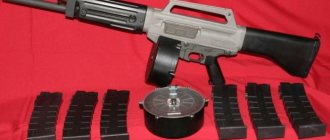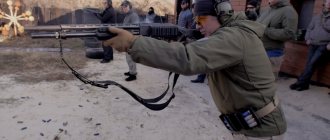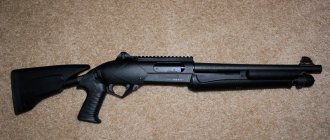A tactical or combat shotgun is a class of smooth-bore small arms, the representatives of which can be extremely effective in hitting fast-moving targets in fast-paced combat and confined spaces. Add to this a wide selection of ammunition: buckshot, shot, live and rubber bullets. Thanks to these features, shotguns have become a common weapon in the arsenals of military and police forces around the world. Kel-Tec KSG was able to bring a number of innovative and interesting solutions to a specific niche that made the shotgun legendary.
Description
The Kel-Tec ShotGun is a shotgun designed with a bullpup design, meaning the magazine is located behind the trigger. The main distinguishing feature of the KSG is the two tubular cartridge containers located under the barrel, parallel to it. In the basic version, each of them holds up to 7 rounds, and the total capacity of the shotgun reaches 14 (+1). This makes it one of the most multi-shot pump-action shotguns, since shotguns rarely boast a large ammunition capacity.
An ambidextrous safety button and loading through a window located at the bottom of the receiver allow the KSG to be used equally effectively from the right shoulder as well as the left. Spent cartridges are also discharged through the loading window. The KSG is equipped with a Picatinny rail mounting system above and below the barrel. On the shotgun you can install: open and collimator sights of various types, a tactical flashlight, a laser pointer, a handle block and other accessories.
position F "fire"
Gallery[edit]
- P-11 9 mm with loaded magazine
- P-32 .32 ASR
- P-3AT .380 ACP
- PF-9 blued finish 9mm with gray handle
- SUB-2000 9mm with 15-round Beretta magazine
- SUB-2000 9 mm, folded
- PLR-16 5.56×45mm with compact handguard and Levang linear recoil compensator
- SU-16A 5.56×45mm
- SU-16S 5.56×45mm, with fixed stock
- SU-16S 5.56×45mm, with stock folded
- SU-16S 5.56×45mm, with folding stock, pistol grip and optical sight.
- RFB 7.62×51mm, with holographic weapon sight and sling
- KSG 12 gauge
Specifications
- Type: shotgun
- Country of origin: USA
- Developed: In 2011
- Designer: George Kelgren
- Serial operation: Since 2011, production continues
- Manufacturer: Kel-Tec CNC inc.
- Purpose: Military and civilian
- Shotgun weight: 3.1 kg
- Weight with full magazine: ~3.86 kg
- Weapon length: 66.3 cm
- Barrel length: 47 cm
- Maximum width: 7.6 cm
- Maximum height: 17.8 cm
- Ammo: 12/70, 12/76
- Caliber: 12 mm
- Magazine capacity: Twice 6 rounds in the basic KSG version
- Operating principle: Pump-action shotgun
- Accessory Mounting: Picatinny rail top and bottom (MIL-STD-1913)
- US price: $990
Kel Tec KSG 25
Operating principle
Reloading of the gun magazines in the KSG is manual, carried out by a pump-action mechanism through the forward-reciprocating sliding of the forend. The shotgun fore-end itself is made of high-strength plastic and is connected to the bolt through two metal rods. The barrel channel is locked by a swing-type combat cylinder and engages the bolt with the tail of the barrel.
Two tubular magazines located horizontally under the KSG barrel are responsible for feeding cartridges, but only one is used at a time. Which cartridges will be taken from is regulated by switching a special lever, which is located at the bottom of the shotgun box. This switch has three states: left, right and center position, which allows you to empty the chamber or quickly throw ammunition into it.
KSG magazine switch
The shotgun is loaded one cartridge at a time through a window located at the bottom of the KSG, between the teeth of the feed fork. The inserted ammunition will go into the magazine that the switch lever is currently pointing at. Each magazine, depending on the KSG modification, holds from 4 to 7 rounds.
The KSG is equipped with a Picatinny rail, allowing you to install the necessary equipment. One of the main and recommended by Kel-Tec representatives is the front handle. It is used to clearly control the movement of the forearm during reloading and protects the hand from accidentally hitting the muzzle during active reloading.
Design
The bullpup layout allows you to minimize the size of the gun. This ensures the greatest comfort in using the shotgun in limited combat conditions. For example, on city side streets, in apartments or inside buses. Thanks to its weight and size, the KSG performs well in dynamic and active work, which is why it is valued by law enforcement agencies.
KSG with optics
Both ammunition containers are fixed in the receiver. Each allows you to load a shotgun with seven 12/70 cartridges or six 12/76 cartridges through a special window. This gives a total capacity of 15 rounds. Next to the loading and ejection window there is a magazine selector.
The shotgun is not equipped with a choke. The barrel has an internal and external diameter of 18.4 mm and 21.8 mm, respectively. Above it is a Picatinny rail. The union nut that secures the barrel in the muzzle panel can be replaced with a door breaking attachment. Around the barrel there is a KSG forend, which is also equipped with a 15 cm long Picatinny rail at the bottom. The forend travel during reloading is 10.4 cm.
You will be interested! Turkish bullpup shotgun Utas UTS-15
The shotgun shoulder rest is entirely plastic, with the exception of the feed tray located at the back of the box. The shutter assembly is compact and small, with dimensions of 59, 18 and 27 mm. When locked, the force-controlled bolt stop moves upward from the bolt block and fits into grooves on the top side of the barrel. The ejector is located on the bottom of the bolt.
The design of the weapon is well thought out, so disassembling the KSG for cleaning and maintenance is not very difficult. It consists of the following steps. It is best to perform them in a horizontal position.
Kel Tec KSG design
Disconnecting the trigger (trigger mechanism):
- Cock the forend.
- Place the shotgun on the safety.
- Press out the USM fixing pins and install them in the special holes.
- After which you can raise the trigger.
The back of the head is knocked out without additional manipulation and removed from the receiver. After that, all that remains is to move the platform with the shutter to the rearmost position and remove it. This way, you can gain access to the barrel and partially clean the shotgun.
To further disassemble the weapon you will need certain tools. But it is also simple.
- To completely disconnect the barrel, you need to gradually unscrew two screws.
- After pressing the forend-fixing plate, the box with tubular under-barrel magazines is easily disconnected, and the bolt pusher is removed.
- All KSG components are now accessible for inspection and cleaning. If necessary, you can also disconnect the forend using a hexagon.
Assembly is carried out exactly the opposite. It is worth paying attention to only three details: 1) the forend locking plate; 2) before tightening the screws, if they spin freely, it is necessary to slightly press the barrel into the box; 3) the shutter is put in place by twisting it 90 degrees. The assembly is verified by monitoring the proper operation of the feeder tray. After assembly, you should fire a blank shot so as not to leave the gun in an erected state.
KSG disassembled
Design features
Let's take a closer look at the main parts of the Kel-Tec KSG shotgun.
Receiver with tubular magazines
Both tubular magazines, located parallel to each other, are fixed in the receiver. Depending on the cartridge length, each magazine can hold up to seven 12/70 rounds or six 12/76 rounds. Together with the pre-chambered cartridge, the capacity of the Kel-Tec KSG shotgun increases to a sensational 15 rounds, and this with a total length of only 660 mm. The magazine tubes, 470 mm long, are soldered together and each has four slotted holes for assessing fullness (one, two, three cartridges, full).
Directly in front of the outlet of the magazine tubes is the magazine selector. This lever has three positions: right, middle and left. In each of the lateral positions it blocks one of the two tubular magazines. Then any of them can be either manually loaded or emptied during firing. If the first magazine is completely empty, the shooter can manually move the lever to the other extreme position to be able to use cartridges in the second magazine. Additionally, see the corresponding note in the “Practice Test” section.
In the middle position, the lever locks both tubular magazines. Behind the lever there is a mechanism that, when reloading, releases the next cartridge for chambering as needed.
Barrel with attached parts
The Kel-Tec KSG shotgun has a 470 mm long barrel with an internal diameter of 18.4 mm, an outer diameter of 21.8 mm and is not equipped with a choke. A picatinny rail (MIL-STD-1913) 310 mm long is mounted above the barrel, which is mainly used for mounting optical sights. The forward of the two massive connecting elements between the barrel and the rib is designated the muzzle panel. On the right and left it contains swivels for attaching a carrying belt. But it also serves as a connection to the magazine tubes. To do this, two screws are inserted into the front of the muzzle panel, which, if disassembled incompletely, can be separated using a coin or a screwdriver.
The union nut that secures the barrel to the muzzle panel can be separated and replaced with an optional door-breaking attachment. If, when opening doors (burglary), you place the muzzle of the weapon directly against the door (to the hinge or lock), this can lead to a rupture of the barrel. Thanks to its holes, the nozzle serves to reduce pressure, thereby avoiding rupture of the barrel. The serrated front prevents the weapon from slipping when positioned.
Around the barrel and tubes of the under-barrel magazines there is a forend, which on its lower side is also equipped with a 150 mm long picatinny rail. An auxiliary holding support offered by Kel-Tes, a tactical front handle, a flashlight or a laser sight can be mounted here. There is also a transmission rod attached to the forend, which covers the bolt block with its rear end. The movement of the forend during reloading is 104 mm.
Bolt block
The shutter assembly, with dimensions of only 59x18x27 mm, is very compact and unusually narrow; In addition, it is very light (weight 140 g). The force-controlled bolt lug, which has a supporting locking surface of 7×5 mm, when locked, moves upward from the bolt block, entering a recess on the upper side of the barrel. If the bolt is open, the firing pin, using a cam curve in the bolt lug, automatically moves back and, in the unlocked state, does not reach the cartridge primer.
The ejector is located on the bottom of the bolt, which, at first glance, is, of course, unusual. The cartridge is guided from above by two protrusions; however, the bottom of the cartridge is not covered. Thanks to this, the interaction of the cartridge and the feed tray, which also serves as a reflector for the KSG gun, is coordinated, and it is reliably ejected even in difficult conditions, even when holding the weapon, equipped only with bullet cartridges, in an inverted position.
Shoulder rest
The shoulder rest is made entirely of plastic, with the exception of the feed tray. It is inserted into the rear of the receiver and secured with a disassembly pin, which is also the rear pistol grip mount. The shoulder rest ends with a 10 mm thick rubber pad. Two recesses in the lower rear part of the shoulder rest are used for attaching a belt. The butt of the weapon is equipped with a rubber butt pad to reduce the impact of recoil on the shooter.
The feed tray is interesting. Rather, it should be called a feed fork, since it consists of two long tines. Moreover, unlike the regular feed tray, it has a second function. While it usually only lifts the cartridge fed from the magazine tube up in front of the chamber, the KSG feed fork, as already mentioned, effectively deflects the ejected cartridge case. In the unlocked state, the feed fork is lowered and is positioned in such a position relative to the tubular under-barrel magazines that the released cartridge slides onto the fork and is centered between the teeth.
Then, when locking the weapon, the fork lifts the cartridge to the chambering line, from where it is moved into the chamber by the rolling bolt. In this case, the feed fork continues to move to the left or right of the narrow bolt, until it stops at the receiver cover. When opening the weapon, the fork moves down only after the bolt has almost completely retracted. In this case, the fork, through the extraction and loading window, pushes out the cartridge case or unfired cartridge removed from the chamber and, thus, takes on the function of a reflector.
Lever
All controls on the Kel-Tec KSG, not including the handguard, are located on the grip block. They are made double-sided, and the KSG gun can be used absolutely equally by both left-handed and right-handed shooters. There is a release lever at the front end of the trigger guard. It serves to be able to unlock the bolt when the weapon is loaded to remove the cartridge. A transverse safety slider is located at the upper end of the pistol grip. There are small inclined guards on both sides in front of the fuse.
When quickly changing weapons, that is, if the Kel-Tec KSG shotgun is slung on a carry belt to, for example, change it to a short-barreled weapon, they should prevent the safety from switching. When using a safety slide, this may well occur due to contact with the shooter's body or equipment. Small protrusions that do not interfere with weapon handling effectively eliminate this possibility. There are two holes in the pistol grip that serve to accommodate mounting pins when the weapon is disassembled. The handle block is also secured with two pins: the front one connects the handle block with the receiver, the rear one with the receiver and the shoulder rest. For further partial disassembly of the weapon, only a coin is required to separate the magazine tubes from the barrel.
The design of the trigger assembly is very interesting. In almost all types of bullpup weapons, the trigger mechanism is spatially significantly removed from the trigger. As a rule, it is located below the bolt, since this is where the trigger of the firing mechanism is located. The movement of the trigger is transmitted through the pusher rod. Of course, this option has the disadvantage that the pusher has an extremely negative effect on the characteristics of the trigger (friction, moments of force, etc.).
The designers of the KSG shotgun took a different route. Here, the entire firing mechanism is located in the grip block in the area directly above the trigger, and only the trigger is moved back. Thus, with the help of a pusher rod, only the energy of the mainspring is transmitted back, and since this has only an indirect effect on the characteristics of the trigger, I liked the KSG shotgun because it has an extremely good trigger for a bullpup weapon with a warning - after 3 mm of preliminary travel, an increase in resistance is felt. The trigger fires at 3850 g (measured value), but subjectively the trigger force is perceived as much less.
Another feature is the type of springs used for the trigger. While almost all long-barreled weapons usually use compression springs, which are compressed when cocking the hammer, the KSG shotgun has a tension spring.
Advantages and disadvantages
Advantages:
- Compact shotgun size due to bullpup design.
- Multi-charge.
- The KSG was created taking into account the combat requirements and tasks of the 21st century.
- Ability to load magazines with different types of ammunition. For example, buckshot and bullets. This will allow you to perform various combat missions.
- Convenient for working in a group, discharging spent cartridges under the feet and forward, and not to the side.
- The ability to use the magazine that is most comfortable (depending on your hand) for charging, while keeping a second magazine as a backup for an emergency.
- Good weapon balancing, both with a full magazine and with different amounts of ammunition.
- The shotgun can be used by both right-handed and left-handed people.
- The KSG is comfortable to shoot, and the movement after the first shot is comparable to any other gun.
Flaws:
- The legislation of a number of countries requires changes in the design of the shotgun for its legal use in the country. For example, attaching a DTK (muzzle brake compensator).
- Lack of built-in sighting devices.
- The sight must be high. This feature makes it inconvenient to use some collimator sights. The KSG is ideal for scopes used in conjunction with an AR-15 rifle.
- Some people may find the magazine selector to be a little short. But you can purchase an extended version from Kel-Tec.
- The KSG lacks the traditional shotgun side ejection window through which a cartridge can be inserted.
- Full mastery of the shotgun requires a lot of time and thousands of practice shots.
Modifications
The KSG was created for civilian use, so modifications were not initially planned. However, the rapid growth in popularity of the shotgun in law enforcement agencies forced Kel-Tec to reconsider its position and release additional variations of the gun:
KSG 25 with a barrel length of 774.7 mm and a total length of 965.2 mm, and magazines of 10 rounds. Weight 4.2 kg. Price 1400$
KSG Tactical with a barrel length of 343 mm and a total length of 546 mm, and magazines of 4 rounds. Weight 2.8kg. Price 1200$
Editorial [edit]
The initial release of the KSG received a mixed reception, with some having a flawless experience and others experiencing issues ranging from a broken selector switch to double feeding. Kel-Tec quickly released a second generation to address these issues and also offered to upgrade the 1st generation KSG with the improvements of the second generation at no cost. Other improvements to the 2nd generation KSG include a reset trigger, small inspection holes in the case, and a correction to the trigger to make it easier to use and symmetrical. [5]
